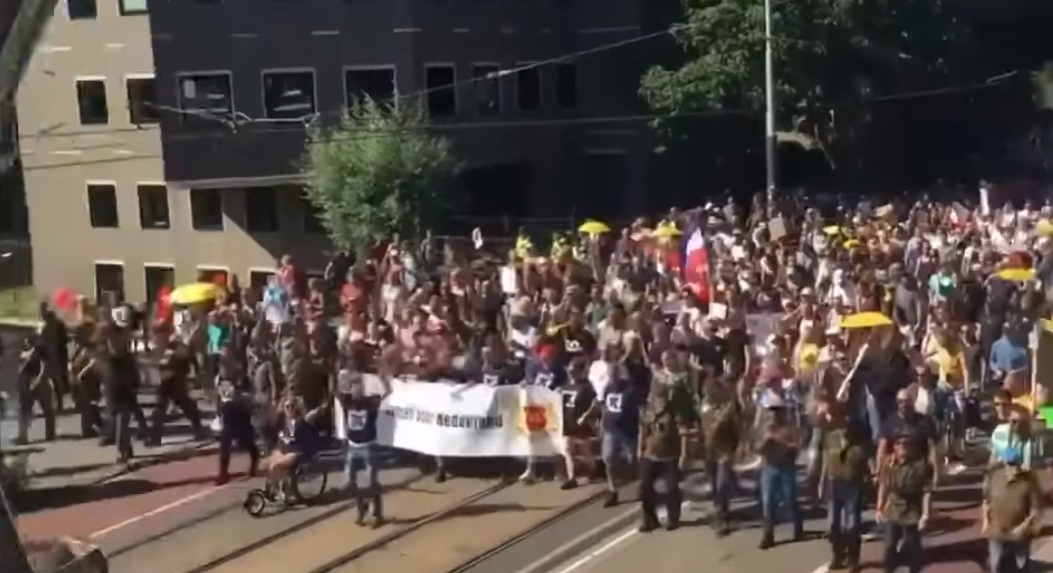PROTECT YOUR DNA WITH QUANTUM TECHNOLOGY
Orgo-Life the new way to the future Advertising by AdpathwayProtest as interpersonal dialogue
But here’s something that I wrote in that 2016 piece. It structured the core idea of the opinion that kicked off the backlash:
Considerations open out into the world and into shared life. Brazilian educator and philosopher Paulo Freire said they point to limit situations on which people differ—for instance, how to deal with global restructuring, with manufacturing and industrial outsourcing, immigration, and intensified poverty. Some people take one side on such issues, others another. This is a limit situation. Asserting one side of it in a shout is not considering it, and it is not liberation.(from "Reconsidering the Aesthetics of Protest")
The idea is that protest’s meaning implies the need for consideration, and that limit situations are good examples of a time when protests make perfect sense, since there is disagreement around important practical beliefs. But critics of the article ignored this idea or refused to accept it as tenable. In a post that no longer exists due to e-flux conversations shutting itself down after the second Trump presidency began, one critic wanted to claim that “consideration” is “liberalism.” But there in the paragraph quoted just now, centrally, is a Brazilian Marxist, an egalitarian and communitarian, who is the only theorist to be mentioned in the entire piece on the aesthetics of protest. One would be hard-pressed to call Freire’s ideas classically liberal, and they certainly are not neoliberal!
Suppressing Freire allowed the critic to suppress the interpersonal by avoiding the central role of dialogue in liberation. But the interpersonal, as a category, is needed to reclaim democracy from authoritarianism. Checking “liberalism” at the door allowed further authoritarianism to seep in: Why be allergic to classical liberty when it is fundamental to safeguarding against authoritarian violence? Why convert dialogical socialism—clearly, Freire’s viewpoint—to apparently ineffective “liberalism”?
The critic wanted to urge his readers to become more tactical and strategic. He was gunning for war by protest. The lack of the relational sub-structure was evident in what the critic could not see, literally not getting his head around it and mischaracterizing the situation. He attributed to my position the view that protest is “self-expression.” But not only was that phrase never mentioned in the 2016 piece, the centrality of Freire meant that we are dealing with dialogue. The one is monadic, the other dyadic. Dialogue is interpersonal, neither self-absorbed nor self-indulgent. It is intersubjective and grounded in a relational concept of people, not an atomistic concept of the individual self.
Realizing that this interpersonal logic of human life is part of protest surfaces a number of things. First, the central example of the 2016 article—that of protesters shouting at the sky with no respondent present—is there to reveal the logical problem of “protest” not being shaped relationally. If, as Freire assumes, human beings are relational, interpersonal beings, then to conceive of acts that are democratic in a non-relational, monadic way is to alienate those acts from our humanity and to avoid democracy. This is what shouting at the sky does: it reveals our alienation and is democratically impotent. Then such “protest” is largely self-defeating, not self-expressive.
Secondly, focusing in on relational logic shows that conceiving of protest as a calculative force is also alienated. The critic viewed protest as technology, that is, instrumentally. This explains why, in the face of an opinion piece that makes no pretension to do descriptive sociology, comprehensive social movement history, or the like, commenters could project onto my essay that it must be a historical analysis of what the thing is that people call “protest” and of what it can do as a social force. Dutiful inheritors of Foucault, perhaps, would then take my moralist’s piece—a provocation that is normative, not descriptive—as a study of forces in a social field so that they could suggest how inadequate it is at doing that. This, though, would reposition the normative discussion of protest and of democracy into a descriptive discussion of effectiveness within a field of social forces in order to reposition protest as calculative, rather than as a relationship emerging in community. Another narcissistic move.
Worse, many of the critics further entrenched alienation by conceiving of the scene of protest through an authoritarian concept of power. This move is the third thing to surface. It was crucial to the purportedly Leftist critics that power be conceptualized as power-over people, not as power-with (or better, “power between”) people. Presumably, power-over people should be the problem that democratic action overcomes. But in a narcissistic view of the world, power-over became both problem and solution: protest as a tactic of dealing with power-over people must be wielded tactically to have power-over the problem and to manipulate those maintaining it. As Jansen and Osterhammel have suggested, such a move reproduces the sovereignty fantasy of empire and is thus a return of coloniality, rather than an advance of decolonial collective autonomy. In simple terms, too, what we have here is a vicious cycle that rationalizes protest, counter-protest, and even state tactics as acts in a world of forces. The resulting picture alienates democracy by way of omitting the relational nature of being human.
We need to understand the relational nature of consideration and Freire’s use of Jaspers’s idea of a limit situation in order to see what democracy involves and what we should assert as our shared presence and field of goals in protest. Cynical critics like the ones I faced, of course, needed to minimize consideration—first by reducing what is clearly a philosophical concept in my hands into a naive term of conventional speech. This led a number of them to try to blunt the quake of actual dialogue by calling the idea of consideration “civil conversation,” not protest. There then followed the diatribes that have become all-so-common on the extremes of the political spectrum about how such conversation is mere “politeness,” rather than flowing from the causes of indignation and the fundamental interpersonal and impersonal violences that drive protest.
Alternately, in a moment that showed some awareness of the novel use of consideration at work in the Freire passage, the main critic I faced suggested that a protest centered around “consideration” projects the classroom onto the street (and projects the intellectual as a “facilitator” onto social movements). To my mind, the picture that is painted is of a neoliberal complicit with the management of populations condescendingly trying to tell people to be nice when we are legitimately outraged and violated as human beings, when we are invisible, or when we are facing either our fundamental inequality vis-à-vis some repressive state apparatus or our fundamental irrelevance in a field of market forces. But this is not where Freire is coming from—nor my own position. It’s much too easy—and convenient—to beat up on dialogue! What’s really hard is to figure out how to structure social movements in order to maintain it.
The structuring challenge of consideration
Consideration marks the collective act of activating the relational space between people to construct a shared world. The word’s root comes from a Latin root that means to examine, in fact, to examine with. It coheres epistemically and practically with the testimony, or witnessing, implied by the core concept of protest. The protest puts what should be considered out there, and what is called for is collective consideration. Neither of these moments are conflict free or avoidant. They confront a lack of accountability, and they call for working through difficulty by really examining things.
Take first the part about considering social reality. Freire’s entire project involves a rejection of education as an authoritarian act—including the neoliberal authoritarianism of “facilitation.” It in no way models education on the classroom. Rather, it is centered around a situation of deep vulnerability that comes with being poor and lost to the world: the community meeting—not a classroom!—in a time of deprivation. This is the historical context from which it developed and for which it was primarily meant. When the one critic tried to suggest the picture of micromanaged, classroom chitchat, he showed that he hadn’t read Freire. Everybody can learn from everybody in Friere, and the best time to learn is when people really need to become free and to insist on their equality in solidarity.
Take, then, the second part about constructing a world that makes sense to us all. Any world in which the question of making good sense arises, any world in which what it is to share power is raised, will be a world that must work through conflict. If this was not entirely clear in my original piece, it should not have taken much to imagine when my core aesthetic example from the art world was of “socially engaged aesthetics.” Socially engaged aesthetics centers on the tensions that arise between people as members of polities, on violence, invisibility, exclusion, deprivation, on democratic powerlessness in the face of impersonal, corporate greed … There is no way to make consideration “merely” polite here. Rather, we have to hear how true politeness involves grappling with political conflict (hear the “polity” in “politeness”).
The question then for both considering social reality and world-construction is how to bring in, or open out to, the others who oppose you on some particular view or across the board by some platform or ideology. This involves refusing to demonize and project these others into object-space as unreachable, evil, mere cogs in a machine, etc.—this move being categorically yet another narcissistic and self-absorbed act rationalized as “politics.” How can protest be structured accordingly, especially when the others are acting narcissistically?
Uneven ground and the allure of war-mentality
So, we see some of the kinds of things that were at stake in the repeated figure of the space between us that is central to my initial piece and which was blocked out of the imaginations of the critics to reserve protest for the space of tactical manipulation of others. At the time, there was a set of vehement objections raised in the lengthy comment section of the Hyperallergic article (down to the odd invocation of “self-expression” which isn’t found in the actual article). This set of comments came from a loose network of Disqus users who appeared to follow and “upvote” each other. At the center of their network of concerns was both the concept of power-over that I’ve previously mentioned and the idea of power inequality between people in the protest situation. This idea raises the most important criticism for someone coming out of the communitarian tradition that Freire marks. It challenges the possibility of power with others.
The idea is that there is a war. One side has the high ground—for instance, an authoritarian government sending troops to large cities with potentially large populations disfavoring the leaders of the government. The other side has the low ground—an everyday person in the city struggling to make ends meet. In this war, fighting against the authoritarian government is unlikely to be successful, because it has the high ground. It has vast power over the situation and over the everyday person. It has massive legal capacities, law-enforcement networks, property laws, and the capacity to sway public opinion.
Now comes the everyday Jane, living out of a pay-by-week motel, struggling to pay her bills, ashamed, looked down on by her family, avoided by people as a reminder of the society’s brutal economic precarity. What can she do? Can she go speak nicely with the troops? Can she ask them to “consider” her? She is just an irate and struggling person, and they are trained not even to listen to her, the government officials going on with life well out of sight of the troops. There’s a massive power imbalance there. Yet facing such imbalances should be one obvious kind of situation where protest is apt.
Against this problem, the position I gathered from many of the rad critics is that protest could make sense only as a threat—a thousand thousand everyday Janes and Joes to shut the city down while the troops get confused and the economy halts, unsettling the government clowns. This was also the view that outspoken rads like Natasha Lennard romanticized in reporting on the #distruptJ20 black bloc actions that triggered the oppressive power-over apparatus of Washington, DC and the Trump administration’s influencing of it in 2017. Protest is a brick—or a hammer and a boot—through a window.
I will call this “counterpower-over.” The idea is that against power over people, we must exert a counterpower over the oppressors. We could debate the tactics of this viewpoint, which extend the reach and deepen the grip of the police state. But then we would be accepting that the way to deal with power-over people is through power-over others, and would merely debate “tactics.” This is precisely what the communitarian democracy of the relational view of power denies. It denies counterpower not because it may or may not be effective, but because it is not democratic. To echo Foucault from his preface to Anti-Oedipus, counterpower is still authoritarianism in our heads and hearts.
The adverbial qualification
The United States of America faces a situation today where dialogue seems impossible and protest exists on a continuum from self-absorption to violence. What would a more developed concept of protest be that is centered on undoing and restoring the relational substructure of community? This turn toward something new (to the contemporary scene) would help to undo cycles of violence, not to reinforce them in a vicious circle of reactivity and counter-reaction formed around the objectification of others and the hollowing out of oneself. The entire continuum from self-absorption on is potentially violent because it is structured by an abusive logic or one that is at the core of abuse. This is the moral pathology: the denial of others as centers of autonomous life and the dispensation to control others, to use force over reasoning, often via manipulation and rhetoric.There is a power-reversal in the aesthetics of protest as I have understood protest normatively. Rather than accepting that we are positioned as objects by objectifying institutions such as authoritarian regimes, people who will claim their own democratic being must claim themselves as having democratic agency starting from how we approach the world. In this viewpoint, the most important effect at stake in political struggle is the first one of becoming visible in the field of sense as a person who shares power with others. Continuous with this disruption into the locked-up field of oppressive sense is the eruption of insisting on the how of democracy. Let me explain.
At the core of democracy is the idea that power must be shared between people or it is unacceptable. Democracy is a way of life, not simply a set of voting institutions. As such, democracy has an adverbial dimension. How we protest is as important as what we protest. If we protest in such a way that we do not project the sharing of power, then we are not acting democratically. We are undermining in our manner what we might be seeking in our thoughts. We are quite literally disempowering ourselves qua democratic subjects, and we are depersonalizing ourselves by depersonalizing others. When we turn people into objects—for instance, the Starbucks workers and coffee drinkers inside a shop that gets its windows hammered down, or the police who oppose us in protests—we are acting undemocratically.
Find the limit situation
We don’t get to yell “democracy!” and act undemocratically. That’s the adverbial point. Let’s now return to the idea of a limit situation that I singled out in my allusion to Freire in my Hyperallergic article. In a popular essay with no other technical jargon, the use of a technical concept from Jaspers’s existentialism repurposed to the dialectical philosophy of a radical, Brazilian socialist should stand out to a trained academic. The critic on e-flux, a highly trained academic, displayed a lapse in focus. Why?
One answer could be that the thing that had to be protected was an authoritarian premise, an abusive one. This premise would be that tactics, not interpersonal responsibility, must dominate the scene of protest. Yet the relational substructure of protest is interpersonal responsibility, contradicting the narcissistic drift of tactical protest forms.
This speaks to our time’s limit situation. Grave distrust in the capacity of others to share community is the limit situation of this time now. It has been growing so over the past decade all across the political spectrum, but mainly in the extremes. In Freire’s usage, limit situations are architectonic decision points within institutional and ideational arrangements that oppress and divide people. Limit situations do not just fall on the oppressed. They also structure the oppressors’ lives.
Freire’s idea seems to be that in a society where people are set up in conflict with each other—some exerting power over others and all having their capacities for interpersonal relationship and human agency undermined to some extent—there will be a problem structuring the polarizations, tensions, and divisions around which sides and oppositions set up. People will disagree and disconnect around this problem, but only because they share it. The problem, then, both structures and conceals their shared life, recasting it in antagonistic terms and thus dehumanizing everybody to some extent. The limit situation is the point of decision within the problem where people divide in order to structure their lives coherently.
In searching for this consideration in social reality, Freire was developing a tradition with deep roots in radical social philosophy as far back as Rousseau’s Discourse on the Origins of Inequality among Men (1755). This tradition assumes that conflict is constructed and tries to find the ways that those apparently at war with each other are actually identified beneath and through the construction of the conflict. For instance, the tradition that reminds striking laborers and baton-wielding police that they are each deployed in a form of exploitation that deflects away from the unequal distribution of social possibilities is part of this tradition. The police, too, are often poorly trained, scared, overworked, and employed in the absence of what they might take as better options, had they different ones. Limit situations are Freire’s way of reminding us conceptually, not just sentimentally, that those who confront us are people too. They have had to make decisions in the situation we share. The limit situation calls us to consider, critically and reflectively, the way the conflict is constructed to create a division in human community around which different decisions have been made.
One of the things that set up the current moment’s limit situation of profound social distrust is the prior half-century of neoliberalism, especially as social media have operated through it. This half-century of erosion of the bases of common life has primed the present moment for authoritarianism. Following Wendy Brown’s work, what made neoliberalism an especially pernicious form of capitalism was that it hollowed out democracy and collective consciousness from within, dissolving, e.g., an awareness of class or of solidarity groupings in its radical individualization of people into their competitive potential against each other. By working on the public sphere and making it subservient to financial values, by radicalizing the education of individuals and the ethics of individual performance, and by reconfiguring all human collectives as mere reconfigurable sets of individuals arranged for market performance, neoliberalism ate away at democratic agency and solidarity. It diminished our capacity to think, say, and be a “we.” This laid the ground for authoritarianism by forming new channels of narcissism, isolation, and precarity.
Neoliberalism, the precursor to today’s authoritarianism, was a deeply corrosive foment and formation of narcissism across populations. It set up antagonism through atomism and self-objectification forged in precarious competition. I am positive that people such as the critic I engaged, Lennard, or the commenters on Disqus I mentioned would vehemently object to being caught within what was then still neoliberal logic, but I do not see how they could not have been. By insisting on “power” as a field of forces that must be strategically threatened to move people as objects toward the goals they thought desirable, and by consistently belittling and minimizing the power of human communication and solidarity to act democratically (i.e., in that adverbial manner), the counterpower radicals were complicit with the logic of individualization, market objectification, and the dismantling of collective power-sharing. They primed authoritarianism too, cavorting through a logic of violence with the proto-authoritarian formations they opposed. They did not seek authoritarianism, but they promoted it, indirectly and unintentionally.
This all flowed from adopting the view of power that they did and from rejecting the possibilities of what I have been calling—in a communitarian manner indebted to Freire—interpersonal consideration. They literally said that consideration is just being “nice,” but I want to say, “Nice try. You are being proto-authoritarian radicals.” You may not intentionally mean to do so, but you are reproducing ideology and tactics that contribute to a vicious cycle splitting the “we” and leaving collective power as a form between all of us precarious.
Underneath specific contested issues, whether we will be is the depth limit situation that appears within narcissistic struggles around manipulating others and producing authoritarianism directly and indirectly. The authoritarian and the power-over protester actually share one set of answers to this limit. They divide around the limit by locking in an antagonism of shared premises that perpetuates itself.
Use relational, not practical, reasoning first
But there is another way to decide on the limit. It is to get over tactical manipulation as a viable way of protest. In the contemporary situation of my society, the United States of American, equivocation structures many of the central terms—“protest,” “power,” “democracy,” and “consideration”—so that people such as the critics I mentioned and myself are not even referring to the same things. Still, the disagreement is productive, because at bottom we have a different way of approaching how to deal with anti-democratic institutions and ideations in our society.
The tactician narcissist protesters take the perspective of practical reason, typical to the French tradition they often cite favorably (this same viewpoint also infuses the Deleuzian and Guattarian overtones of Lennard’s perspective: the “becoming war machine” of the anti-fascists). Here, protest is instrumental. It is seen in terms of its effects. One can assess it calculatively and strategically. It is temporary, one action in a set of actions that can constitute a political life. Seeing protest as a complete action, as practical, has deep roots in the tradition of Greek philosophy, too, up through the emphasis Marx and the Marxist tradition has often put on it.
My approach, however, comes from the centrality of relational reason to being people. This approach is rooted not in the Greeks, but in the dialectical tradition of intersubjectivity begun in Rousseau and developed by Hegel, Kierkegaard, and then an entire twentieth-century phenomenological and sociological tradition of intersubjectivity, one deepened significantly by feminist work on relational freedom. Marx is largely silent about it, which I take to be one way he can rationalize violence and allow a tradition following him to rationalize totalitarian methods. I also think that the extent to which the critics and certainly Lennard either own violent concepts (such as threats) or openly advocate violence (such as punching people you hate) is largely made possible by completely ignoring relational reason. Relational reasoning is about facing people and engaging them.
From the perspective of reasoning relationally, protest is not simply an instrumental action, and it is not a stratagem. It is a manifestation of our communal potential, an assertion of solidarity, and it cries out for a space between us that is just and loving. In this space, people are not objects—neither the oppressors, nor the oppressed certainly; neither the police, nor the protesters; neither the neo-Nazi nor Donald Trump. The object world, in fact, is bracketed as secondary to the centrality of persons and their potential for relationship. Conflict is not avoided, but is faced. Violence is not endorsed, but is eschewed. The adverbial dimension of this protest is thoroughly democratic, and it is thoroughly anti-authoritarian, because it begins with the centrality of common humanity.
The centrality of common humanity, moreover, shows how this perspective cannot be classically liberal. Classical liberalism is a relation between people and the state that redirects civic republican freedom into negative liberties. Here, freedom from fear and from tyranny is handled by constructing people as individuals with rights not to be interfered with by the state or, by extension, each other. It is not grounded in “we,” but in “me.” The perspective I am working from, however, is communitarian and, I would add, civic republican, because there is no “we” when we can’t look each other in the eyes as human beings.
“We” can’t be assumed. It is a starting point that in actual life becomes what Kant called—in the Critique of Pure Reason (1781)—a regulative idea. “We” can only be worked for and worked through. Its idealism produces what Foucault called (in his “subjectivation”-facing works) a “critical attitude” on any assumption of “we.” It is always incomplete, and it is always open. This explains why, in it, many more possibilities for protest open up—normatively, not descriptively!—than have been catalogued by the strategists of force. For protest is actually a way of life in the relational perspective. It is a way of centering oneself on the common and attempting to expose and to construct it wherever “we” go. The move is anti-identitarian and open to self-transformation alongside novel assemblies of collective agency. This is why socially engaged art is such a useful thing to consider right now at a point in time when authoritarianism looms like never before in the United States of America.
“We the people” do not need more calculative locking-up in cycles of increasing suppression and objectification complicit with authoritarianism. We the people deserve democracy as a way of life. And for that, outraged, everyday people could benefit from normative concepts of protest that act as powerful potentials to open up our imagination. Let’s un-work and rework all the myriad ways that neoliberalism and now authoritarianism have wound themselves around being human, choking out our collective ability to share power.
(next month’s post)
The core of this post was previously published in February 2017 on e-flux conversations as "The Neo-liberal Radicals," a site that was deactivated after the second Trump presidency began. I composed a new post around that kernel.
Jeremy Bendik-Keymer
Professor of Philosophy at Case Western Reserve University | Website
A lover of good discussions from the kitchen table in 1970s-80s Aurora, Ithaca, and New Hartford, NY, then the cafés nearby the Lycée Corneille in Rouen and the Daily Caffé in New Haven, CT, after the fact, too, from high school soccer and swim teams from New Hartford, NY and punk and post-punk culture in the '80s and '90s (where the discussions were musical and physical) as well as from college seminars, Leonard Linsky's Philosophical Investigations reading group, and the Chicago Commons Reggio Emilia-inspired Family Centers of the '90s. Rock on to Wooglin's Deli Friday Conversation Circle in Colorado Springs, CO; the Conversation Circle at American University of Sharjah, UAE; The Ethics Table at Case Western Reserve University; the Moral Inquiries at Mac's Back's Books in Cleveland Heights, OH; and neighborhood philosophy now. I like to organize workshops where no one presents a paper but rather people meet to explain their research around a common theme, letting the event feel like kitchen table talk and not some defense of theses or product deliverable.


















.jpg)






 English (US) ·
English (US) ·  French (CA) ·
French (CA) ·